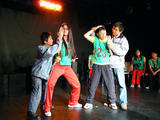
All to play for
Theatersports enjoys a popular following in Europe and North America but has only recently made inroads into Asia. Check out some of the top "competitors" from Japan, Hong Kong and Taiwan at this weekend's Asia Impro Movement.
By Noah Buchan
Staff Reporter
Friday, Sep 07, 2007, Page 13
Ever felt like yelling out in a theater performance, but were too afraid? Or felt that shouting out your opinion was inappropriate or rude? Well beginning tonight at The Mayor's Residence Art Salon prepare for a performance in which the audience can become the actor and passive spectators are frowned upon.
"I always emphasize [to the audience] that in this show we work together," said Taiwan's Guts Improv Theater (勇氣即興劇場) founder and this weekend's Theatersports' emcee Wu Hsiao-hsien (吳效賢), referring to the relationship between audience and actors.

It's a sentiment shared by Japan's Impro Works and Hong Kong's Champion Arts Association (青皮人藝術合作社), the other two companies that have come to Taiwan to compete in the Theatersports contest.
"Competition is just the format," said Shirley Chan (陳明慧) of Champion Arts. "We are still working together and we are playing." Though it"s cloaked in competitiveness, the purpose of the performance is to suck the audience into the action on stage, turning them into creators as well as observers.
Let's rumble Theatersports is a performance style that finds its origins in improvisational theater (improv or impro, depending on the dictionary you use) and stresses the importance of the audience's active participation. It involves two different formats: long and short. Short form is more competitive in the sense that two teams take the stage at the same time. The long form involves one team and lasts for 30 minutes. This weekend's performances will be held in English and Chinese.
Theatersports is a performance style that finds its origins in improvisational theater (improv or impro, depending on the dictionary you use) and stresses the importance of the audience's active participation. It involves two different formats: long and short. Short form is more competitive in the sense that two teams take the stage at the same time. The long form involves one team and lasts for 30 minutes. This weekend's performances will be held in English and Chinese.
Though each improv company approaches Theatersports in a slightly different manner, the basic format includes teams of actors - professional or otherwise - performing in front of judges while an emcee implores the audience to shout out their ideas, suggestions and criticisms, particularly to the judges.
"In Japan, the judges' status [in society] is very high, so it is seen as very rude to criticize them. So I explain before the performance begins that judges are supposed to encourage the audience to criticize them," said Yuri Kinugawa, art director of Japan's Improv Works.
Champion Arts Association uses a different format. "We ask the audience to be the judges. We will explain [the format] before the show and ask for suggestions because that will involve more [of the] audience. Though some audience members really don't want to get involved in the performance or even give any suggestions, they are always willing to give marks," said Chan.
The Taipei competition will employ three judges and suggestions will come from the audience.
Communicating with the audience members and making it clear they are to be active participants, the three companies agree, remains the biggest obstacle confronting Theatersports in Asia.
Cultural obstacles?
She added that audiences in Hong Kong are so used to traditional theater they often remain silent in the theater, even though the emcee is imploring them to speak up. "It is very different from what we have seen ... in Canada and the US, where the audience members will shout and scream and get involved," Chan said.
Still, with an energetic emcee on the mic, even the most reticent of crowds may turn from speechless statues to raucous participants.
"You (the audience) make the show, it's not just us performing for you. We need your input to complete this show," Wu said.
It's an attitude that should keep the audience members on the edge of their seat.
沒有留言:
張貼留言